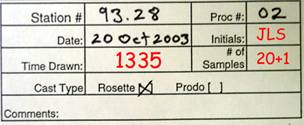-
 The sample bottle number should ALWAYS match the rosette bottle number on full casts – check and re-check this during the sample drawing process. If you ever have any doubt about the sample, dump it and start over. Shallow casts with fewer than 20 salt samples may be combined with a previous station. Check with the watchleader & sample log for the correct sample bottle numbering.
The sample bottle number should ALWAYS match the rosette bottle number on full casts – check and re-check this during the sample drawing process. If you ever have any doubt about the sample, dump it and start over. Shallow casts with fewer than 20 salt samples may be combined with a previous station. Check with the watchleader & sample log for the correct sample bottle numbering.
-
The sample bottles are stored inverted – they should not be turned over until the new sample has been taken. If you need to step away from sampling for any reason and have not filled the sample bottle, return it to the case inverted.
-
The bottles should never be stored empty so as the old sample is dumped, use it to rinse any salt that may have crystallized on the threads, thimble, and cap.
-
Salt samples are usually drawn from the bottom valve. Fill the bottle with ~40mls of seawater, cap loosely, shake then dump, rinsing the threads and thimble (plastic insert). Repeat – you should rinse the bottle 3 times; the dumping of old sample does not count as a rinse.
-
The last fill should be done without interruption until overflowing, filling the bottle completely; pour ~10ml out over the thimble, place it firmly in the bottle and cap. The caps are brittle and should not be over-tightened. If they crack, retrieve a replacement from the spares Ziploc, keeping the thimble in place. See photo for optimal fill height.
-
Salts are taken from all closed rosette bottles unless directed otherwise. If an oxygen sample was not taken from the bottle (LTER extra bottle), you will have to open the breather to start seawater flow to fill the sample bottle.
-
Sample bottles are fragile – carefully place them back in the correct slot. If you drop one on deck or into the case and crack the glass, replace the cracked bottle from the spares case, adding the bottle number to the label. Redraw the sample.
-
Once all the salts are taken:

-
fill out a sample label (on the sample log clipboard) with the time, your initials, total number of samples. Place the label in a plastic sleeve and into the box of samples by salt #1.
-
Take the finished case into the lab, adding it to the end of the salt case queue. Add your initials to the bottom of the electronic sample log’s salt column if not done by the watchleader.
-
Common mistakes are:
-
duplicate draws - drawing seawater into different sample bottles from the same CTD bottle - always check and recheck the numbers match. Be extra cautious on shallow stations where numbering may not match.
-
sample bottles replaced out of order - common when more than one person is drawing salts, be sure you put the sample bottles back in the correct order.
-
sample bottle returned to the case without sample - if you are called away to help recover the nets and need to return the undrawn sample bottle back to the case, be sure you invert it so someone else will draw the sample.
-
missing thimble insert - be sure all salt samples have a well-fitted thimble.
-
not enough air - a cold sample bottle will crack as it warms if there is not enough air space, corrupting the sample.
-
too much air - can shift the salinity value or not give the analyst enough sample to measure
-
cracked or broken bottles from drops or rough-handling - handle the sample bottles gently, the quartz glass is brittle.
Go to top
 The sample bottle number should ALWAYS match the rosette bottle number on full casts – check and re-check this during the sample drawing process. If you ever have any doubt about the sample, dump it and start over. Shallow casts with fewer than 20 salt samples may be combined with a previous station. Check with the watchleader & sample log for the correct sample bottle numbering.
The sample bottle number should ALWAYS match the rosette bottle number on full casts – check and re-check this during the sample drawing process. If you ever have any doubt about the sample, dump it and start over. Shallow casts with fewer than 20 salt samples may be combined with a previous station. Check with the watchleader & sample log for the correct sample bottle numbering.
